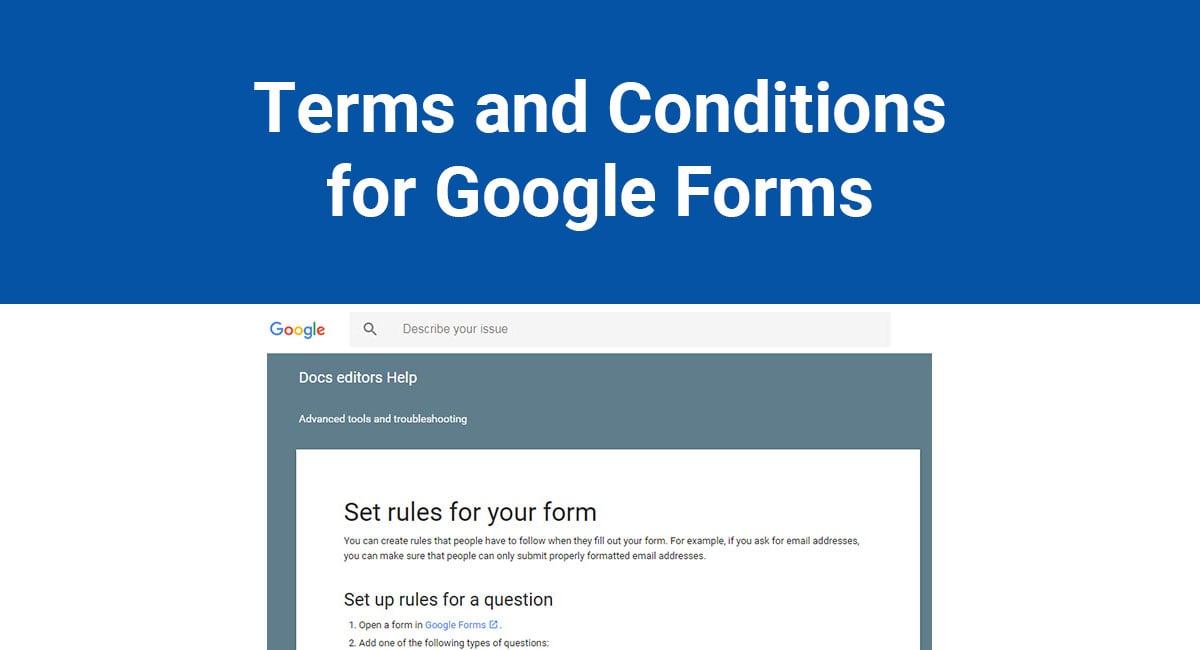

If you use Google Forms, you should absolutely have a Terms and Conditions agreement that you display to the public.
This article will look at Google Forms and the reasons why you should have a Terms and Conditions link on every Google Form you use. Tips for creating a Terms and Conditions that protects you and your business are also included.
Our Terms and Conditions Generator makes it easy to create a Terms and Conditions agreement for your business. Just follow these steps:

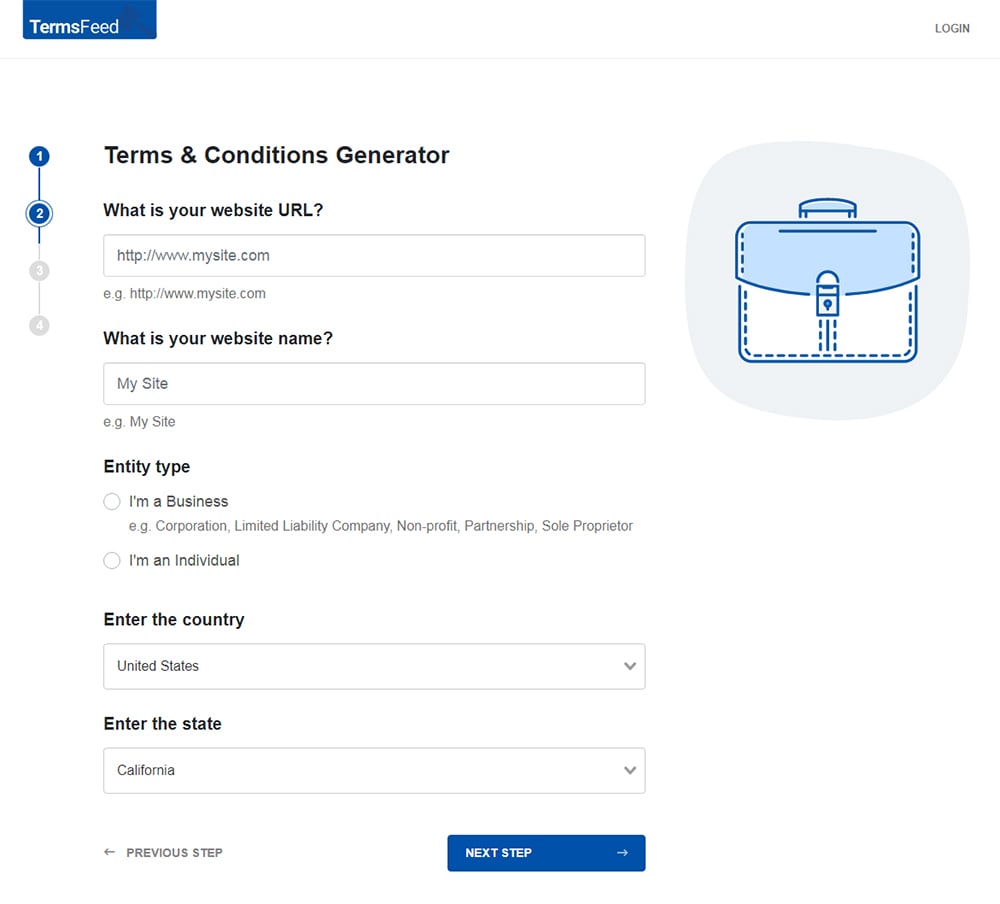

 You'll be able to instantly access and download the Terms & Conditions agreement.
You'll be able to instantly access and download the Terms & Conditions agreement.The internet is filled with different tools that help grow your business. Google is a creator of several of these tools. Google products such as AdWords, Hangouts, Gmail and Google Forms are popular online tools that are free or very inexpensive and provide online storage of the data they contain.
It's estimated that over 165,000 websites are using Google Forms, from Business websites to arts and entertainment websites, and everything in between.
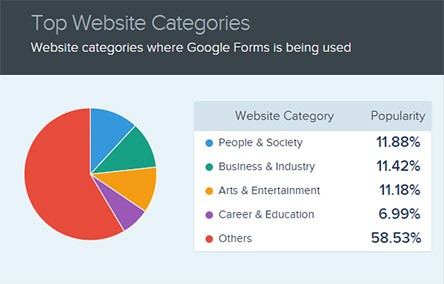
Online forms are versatile, allowing you to create different types of forms for different purposes. Examples include surveys, contact/sign-up forms and even complex questionnaires.
Google Forms provides your business with excellent tools for collecting and storing information. From simple questionnaires to complex intake forms, Google Forms allows your business to gather important data and store it securely online.
It also allows you to set custom form permissions for form access, control and security.
Google Forms also can work with Google's suite of tools, allowing you to integrate spreadsheets, presentations and other features into a custom form.
A Terms and Conditions agreement (also known as Terms of Use or Terms of Service is where you let users know what your rules and requirements are, as well as other important business-related information.
You may have rules and requirements in place for the proper use of Google Forms to help protect your business or the information you are collecting.
Because of this, having a Terms and Conditions agreement linked to your Google Forms is necessary to establish your rights and the rights of the people who complete your forms.
Because of security risks that can be associated with collecting and storing information online, you will want to include a Terms and Conditions or Terms of Use with every Google Form you use.
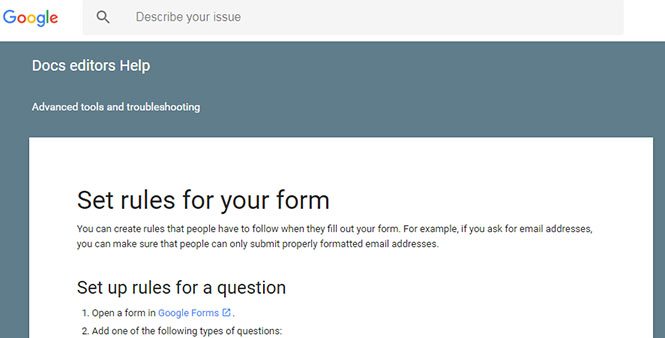
Depending on which features you use in Google Forms, you'll collect different types of data. If your form is for a business, a Terms and Conditions agreement can help establish your right to modify your forms and store the collected data.
For example, you may want to store the data you collect via Google Forms in a Google Sheet or some other spreadsheet.
By storing this information, you are accepting certain rights and responsibilities for protecting that data. You also need to establish limits of your liability with the people who complete forms so they know your rights and limitations, as well as their own. You can do all of this with a Terms and Conditions statement.
A Terms and Conditions agreement is a set of rules a user must agree to if he wants to use a website or an application, including completing an online form such as a Google Form.
Terms & Conditions can be used to address anything that affects your website. Some common points to cover may include:
Unlike a Privacy Policy, Terms and Conditions agreements are not mandated by law. However, creating a custom Terms and Conditions for your website and any online forms you use is highly recommended as a business best practice.
If you don't have a Terms and Conditions for your website, app or online forms, you are leaving yourself open to potential liability or misuse of your site.
Here are a couple of reasons why you a need Terms and Conditions:
Here are a few examples of the types of details you will want to include in your Terms and Conditions agreement.





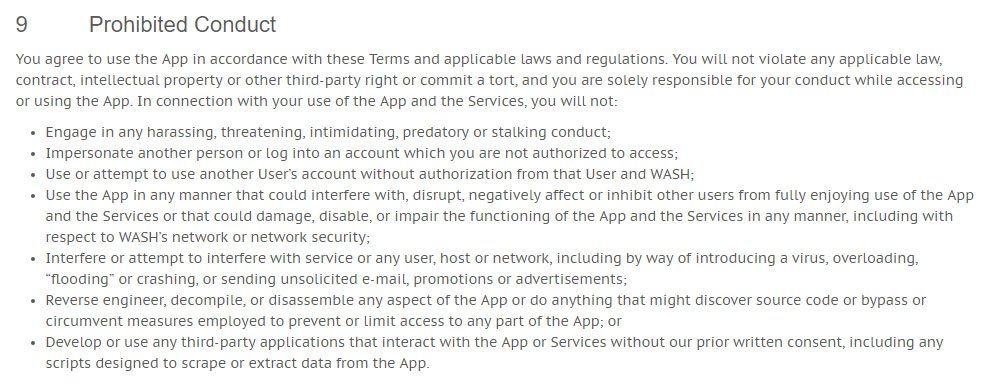
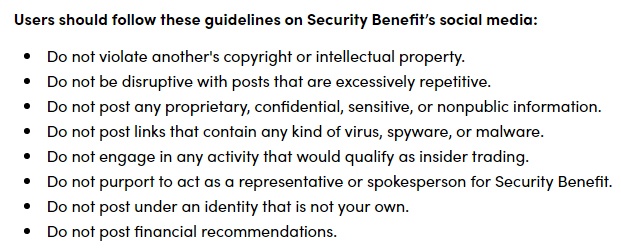
Clickwrap requires a user to tick a box or click a button to show she agrees to something, such as your Terms and Conditions agreement. This click is an online equivalent of a signature.
By checking the box or clicking the button, the user is legally acknowledging they have read your Terms & Conditions and that they agree to it.
Here's an example from Steam's sign up page:
 form with agree checkbox highlighted" width="932" height="603" />
form with agree checkbox highlighted" width="932" height="603" />
Clickwrap contains two key features:
Why is clickwrap important?
Things to consider when using clickwrap:
You want every person who completes a Google Form to agree to your terms before submitting or continuing.
Here's how you can do this:
Open Google forms. Choose a blank form or choose a template that suits you. The following example shows an RSVP form for a boat cruise.
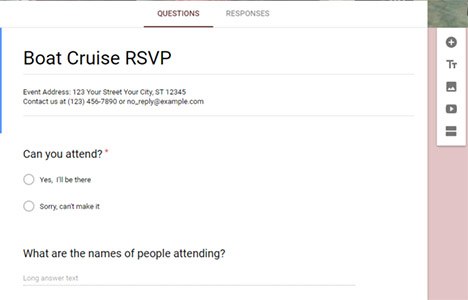
Decide where you will place your Terms and Conditions. This likely will depend on what your terms cover. In your terms cover the form about to be filled, it is important that you place your link to your Terms and Conditions at the top of your form.
Decide whether you will include a link to your terms or include the entire text inside the form. A link is generally recommended. However, if your terms are relatively brief, you might consider including them with your form.
Here's an example:
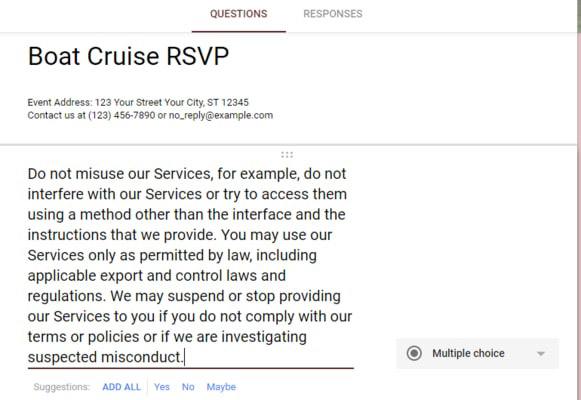
Another option is to add a link to your Terms and Conditions agreement.

Now that your Terms and Conditions has been uploaded, you need to add the option to agree or decline.
To do this, your answer mode selection in your Google Form setup should be 'Multiple Choice.' Add two options as the multiple choice: "Yes, I agree" and "No, I do not agree."
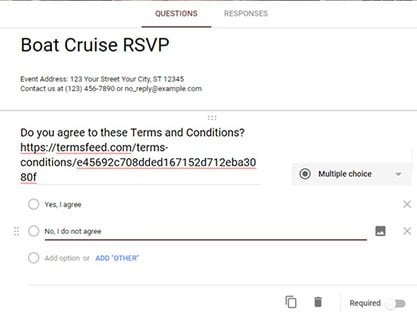
Everyone who clicks "Yes, I agree" will be permitted to continue with completing the form.
Anyone who does not agree to your Terms and Conditions should not be allowed to continue.
Your Terms and Conditions can be placed at the end of your form as well. Users would be able to fill out and select answers, but would be required to accept your terms before submitting their answers.
Here are instructions on how to do this:
Open a blank form or a template to create your questions.
At the end of all the question setups, add one more "Title and Description" and fill the Title space with something like this: "By submitting this form, you agree to our Terms and Conditions."
In the description space, add a link to your Terms and Conditions.

Fortunately, Google Forms makes form setup easy for you and gives you flexibility with how and where you include your Terms and Conditions. Whatever form you choose to use, and however you choose to present your Terms and Conditions, the most important thing is to protect your liability.
Requiring users to accept your Terms and Conditions in one of the ways discussed is the best way to protect your business when using Google Forms.
Comply with the law with our agreements, policies, and consent banners. Everything is included.
Disclaimer
This article is not a substitute for professional legal advice. This article does not create an attorney-client relationship, nor is it a solicitation to offer legal advice.
Last updated on
Appears in
Related articles
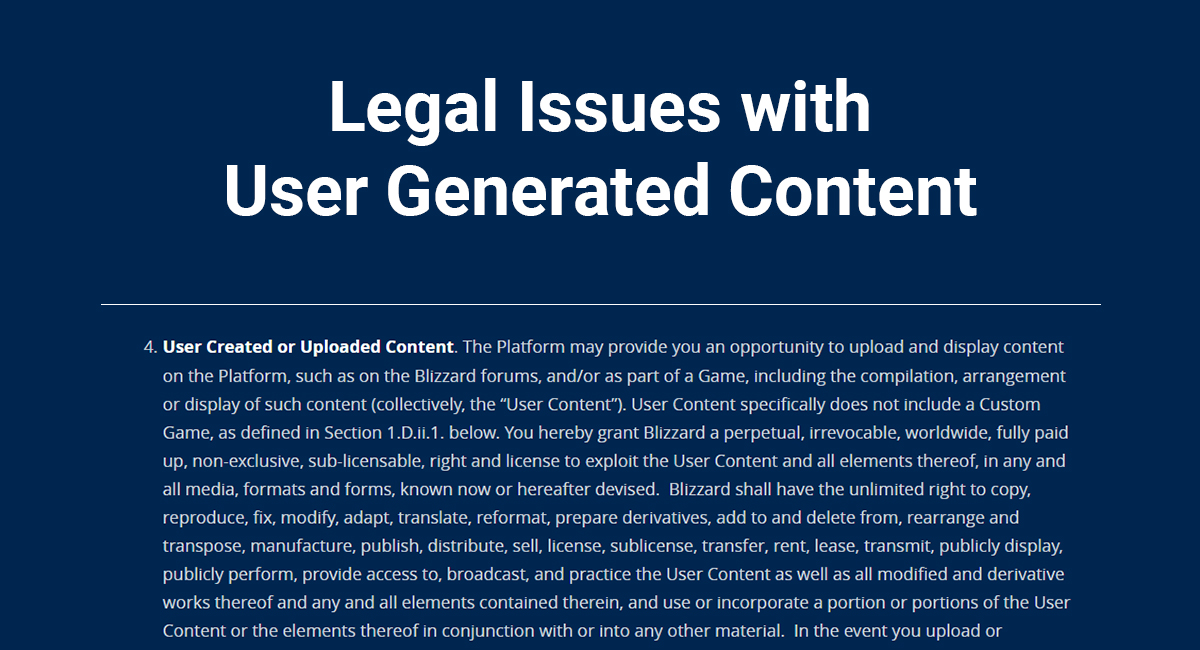
User Generated Content is everywhere. It has become an integral part of what the internet is about. Platforms like YouTube, Wikipedia, and Facebook - whose entire purpose involves around hosting User Generated Content - have become the giants of the web. User Generated Content is a great way for your company.

Your Terms & Conditions agreement, also known as Terms of Use or Terms of Service, acts as a contract between you and your users so you can control liability, manage use of your website or service, protect your intellectual property, and enforce your rules of conduct. While having a Terms &.
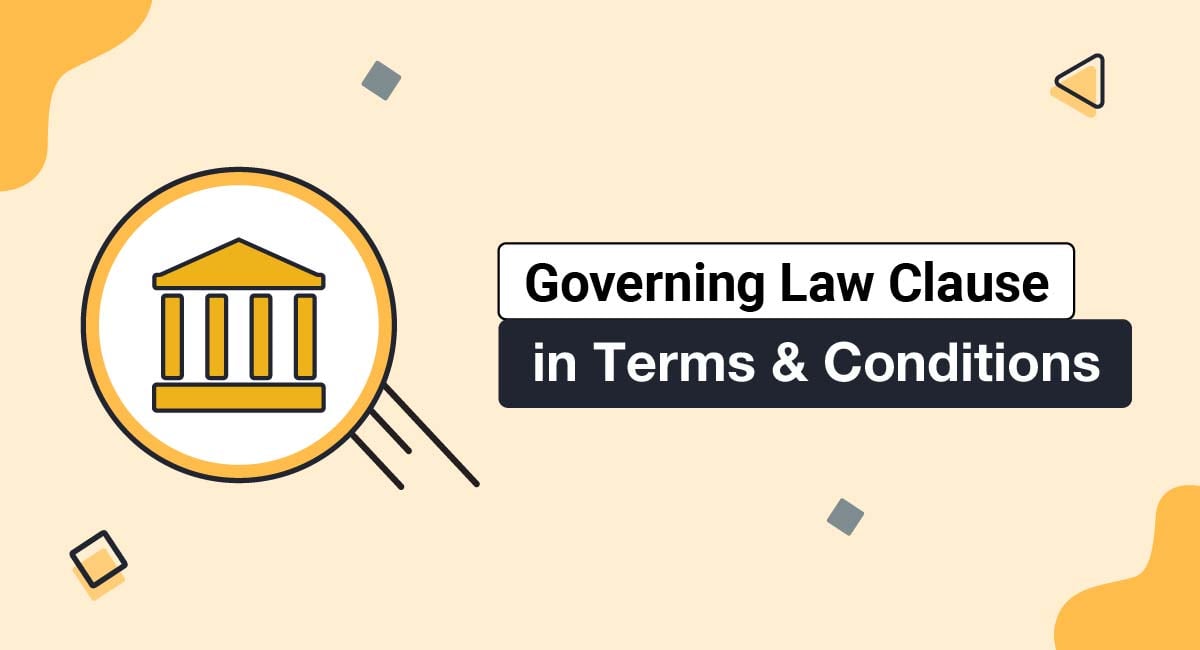
A "Governing Law" clause is a clause used in legal agreements where you can declare which rules and laws will govern the agreement if legal issues arise. This clause will be found consistently in contracts and legal agreements between companies and their users. You can typically find these clauses in standard.
Comply with the law with our agreements, policies, tools and cookie consent banners. Everything you need is included.
Disclaimer: Legal information is not legal advice, read the disclaimer. The information provided on this site is not legal advice, does not constitute a lawyer referral service, and no attorney-client or confidential relationship is or will be formed by use of the site.
Copyright © 2012 - 2024 TermsFeed ® . All rights reserved.